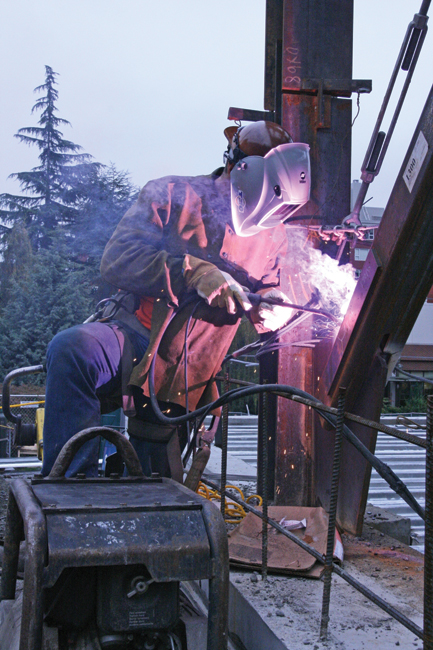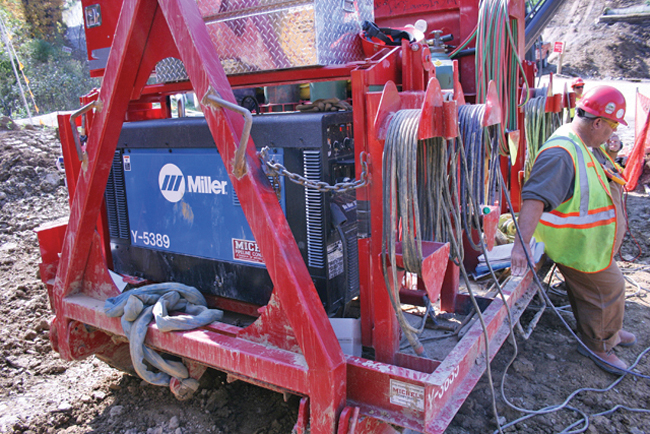Balancing Power, Price and Processes
Tier 4 Final emissions regulations (T4f) go into effect on Jan. 1, 2013, for machines used in the United States and Canada with engines in the 25- to 75-hp range, including engine-driven welder/generators. While that’s still months away, there is much for you to know about the changes that engine-driven welder/generators will undergo and what manufacturers are doing to prepare for these regulations and anticipated price increases. In this article we will look at how this equipment is being redesigned, buying considerations based on output demands (can you get by with an engine-driven welder/generator lower than 25 hp?) and possible ways to improve your processes to offset price increases on new T4f equipment.

What Is Tier 4 Final?
The Environmental Protection Agency’s (EPA) T4f regulations significantly reduce the particulate emissions of diesel engines. This typically requires major engine changes and exhaust after-treatment devices, dramatically increasing costs. All engine manufacturers must supply T4f-compliant engines as of Jan. 1, 2013. There will be some carryover associated with the normal delivery lead time that will stretch into early 2013, which means that some Tier 4 Interim (T4i) engines exceeding 25 hp will still be available for sale after the deadline. The EPA is extending a flex plan to manufacturers that will allow for the sale of a certain percentage of these machines for a limited time after Jan. 1, 2013. That percentage will be identified later in 2012. T4f regulations do not apply to previously purchased equipment, and these regulations only apply to the United States and Canada.
How Will Engine-Driven Welder/Generators with More Than 25 hp Change?
The greatest change will come in terms of price. T4f diesel engine-driven welder/generators greater than 25 hp could increase in price by as much as 50 percent due to engine and installation cost increases. Machines may also get physically larger due to exhaust after-treatment devices added to the engine. These devices get larger as horsepower increases. The new after-treatment devices also give off additional heat, which requires proper machine design to manage airflow while still being optimized for installation on trucks.
What Are Manufacturers Doing to Address T4f?
While the regulations affect engines with 25 to 75 hp, some manufacturers have gone to great lengths to improve machines with engines under 25 hp, providing the performance and output many contractors need at a much lower price point than the new T4f designs will allow. These improvements include maximizing power output and improving fuel efficiency. Similar changes are being implemented on machines greater than 25 hp to help offset the impact of increased prices when they hit the market, but it begs the question: Do you need to buy a fleet of 500 amp machines (greater than 25 hp) when a fleet of 300 to 400 amp machines (less than 25 hp) may handle a great majority of your applications?
Can I Change Processes or Use a Machine with Lower Horsepower?
When you examine most welding applications, you will find that contractors have been buying machines with more horsepower and amperage than they need because greater output was available at a reasonable price. If the difference in a 350 amp machine (less than 25 hp) and a 500 amp machine (more than 25 hp) was only $2,000 to $3,000, many contractors would pay that premium just to have that extra power when needed. In examining construction welding applications, most welders rarely exceed 350 amps, and the majority of welding applications are performed at 250 amps or less.
If you occasionally have the need to run high amperages, whether to run much larger electrodes or to perform carbon arc gouging, you may be able to buy one or two 500-amp machines for those less common applications while buying 350-amp machines for the rest of your fleet. This strategy could potentially save you thousands of dollars in equipment purchase costs, while also adding machines that are smaller, more fuel-efficient and offer a lower total cost of ownership. (To calculate your welding amperage needs, visit www.MillerWelds.com/resources/calculators).

Another way to get more out of a smaller machine is to change processes. The majority of construction welding applications today rely on the Stick (SMAW) welding process. Contractors buy 400- to 500-amp machines to handle large diameter Stick electrodes, but they might be able to achieve the same results by switching to the Flux Cored (FCAW) welding process while transitioning to a machine with less than 25 hp at 350 amps. This requires the added equipment cost of a wire feeder, but that cost is more than accounted for in the lower price of the engine-drive compared to a T4f machine.
The Flux Cored process provides higher deposition rates (more metal faster) at amperage that is easily attained with machines less than 25 hp. It also produces less waste as you use all of the wire, compared to Stick welding where you regularly discard stubs and spend time switching electrodes in and out. Bottom line: You’ll deposit more metal faster, with less waste, and with a machine not affected by the cost increases associated with T4f engine compliance over 25 hp.
Dual operator systems are also an effective option to help lower costs. While some machines fall under the T4f restrictions, they allow two operators to work off of one system (and in some cases, three or more welders with the addition of an inverter running off the machine’s generator power). This can reduce fuel use by more than 50 percent compared to two single-operator units with comparable engine power, and lower total cost of ownership to counteract the price increases caused by T4f.
T4f: An Opportunity to Assess Welding Processes
While some will be discouraged by the inevitable price increases that come along with T4f greater than 25 hp, this is a great opportunity to examine your welding processes and determine if you may be able to get by with equipment that falls below 25 hp not affected by EPA T4f regulations. Manufacturers will also be working hard to improve efficiencies (fuel efficiency, reduced maintenance, added performance and productivity) to offset the cost increases.
Joe Gitter is a product manager for Industrial Engine Drives at Miller Electric Mfg. Co., based in Appleton, Wis.
